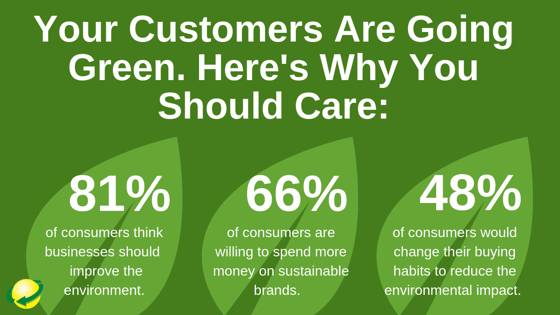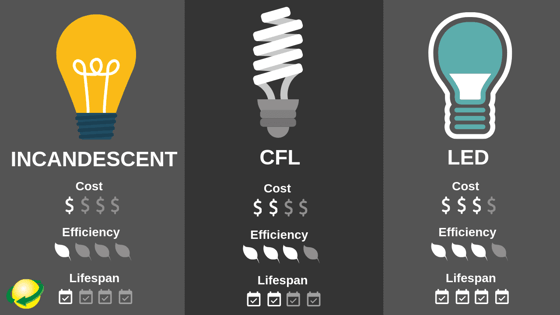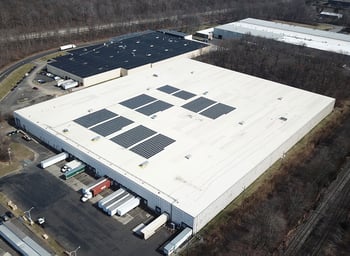Reduce overhead, increase profit. That’s one of the key tenets of many successful businesses. However, as you probably can attest, accomplishing that isn’t always easy. There’s a fine balance between having the resources to create happy, loyal customers and cutting costs - because your competitors make raising prices risky.
But there’s another way to reduce overhead expenses and bolster your bottom line - investing in your own company’s efficiency with environmentally friendly business practices.
From getting smart about supplies to decreasing your energy usage, we’ll share four investments you can make that will save your company some green while, well, going green.
Are Green Investments Really Worth It?
For many businesses, yes. Green investments are a great way for businesses to reduce overhead costs, lessen their impact on the environment, and establish a competitive advantage over others in the market.
Okay… can going green really give your company a competitive advantage? According to Neilsen-back research, yes! A recent report by Neilson shows that 81%[1] of customers feel strongly that businesses should help improve the environment, and 66%[2] of global consumers are willing to spend more money on sustainable brands. And if you’re more green than your competitor, a reported 48%[3] of US consumers would probably or definitely change their buying habits to reduce their environmental impact, meaning you might grow your market share.

Consumers have spoken, and they favor products or services from socially responsible companies. So why not put your money to work by investing it right back in your business?
Making green investments improve the efficiency of your business - and that’s something that will help your company during good times and tough times for years to come. Unlike capital reductions, like layoffs and selling equipment, efficiency improvements won’t hinder your business in the future in return for some cash in the short term. A long-term investment will safeguard your business against economic downturns.
An added bonus? You’ll help the planet, and your customers will love you for it.
Ready to find out how? Read on for our green business money-saving tips!
1. Go Paperless to Save Your Business Money
Here’s one that’s probably been on your list for a while if you haven’t already done so - going paperless. Scan and store important paperwork and documents digitally to greatly reduce the number of hard copies your business prints. Encourage your employees to utilize online document sharing instead of printing things out, and you’ll eliminate a good portion of expenses incurred from printing and document management. It can add up quickly - from the paper itself to expensive ink and toners, to the cost of recycling or disposing of the paper.
Can all the time and money spent converting your business to paperless really be worth it? A study by Multibriefs[4] suggests the average US business spends $80 per employee on paper each year. On top of that, storing and filing these documents takes up a substantial amount of space and resources. All these things can add up quickly and unnecessarily eat away at your bottom line.
Despite what you may think, these numbers aren’t decreasing for businesses year after year. Multibriefs also found that while computers’ integration into the workplace has decreased printing overall, the amount of paper used still increases each year for 19% of companies[4].
And it turns out going paperless will help you save more than just some trees (and money). Paper manufacturing is the third-largest user of fossil fuels in the world[4].
2. Start Telecommuting
One thing we learned during 2020 is that employees can be productive when telecommuting. While it's not practical for every employee in every business, there are many roles that lend themselves to efficiently working from home. While telecommuting offers other benefits like a larger pool of job candidates, it also contributes environmental and money-saving advantages as well.
According to Global Workplace Analytics, US businesses would save $700 billion each year by allowing employees with compatible jobs to work from home just half of the week. That boils down to an average savings of $11,000 per telecommuter [5].
If you’re concerned that giving your employees the freedom to work unsupervised would lead to a downturn in productivity, research suggests the opposite. Because employees have more freedom and can limit distractions, 86% of them believe they’re more productive at home. That’s backed up by two-thirds of managers who agree[5].
By taking cars off the road, you’ll be saving the planet from a substantial amount of greenhouse gases as well. If the same population of employees mentioned above drove to work 2-3 days less each week, it would be the equivalent of taking the entire New York State workforce off the road[5].
3. Reduce the Amount of Electricity Your Business Uses
According to the US Energy Information Administration, the average business spent $654.71[6] each month on electricity in 2017. And like almost everything, electric rates continue to increase, meaning that number goes up year after year.
While how much you spend varies dramatically depending on what region and industry you’re in, chances are, it’s a significant portion of your business’s overhead.
So much of what we do on a daily basis is dependent on electricity - but what if we could reduce that number? In recent years, high rates and a desire for more sustainable business practices have created many energy-efficient replacements.
LED and CFL Lights
One example is CFL or LED lights. Transitioning to these more efficient bulbs may take a bit of an investment upfront, but the reduction in your electric bill and their much longer lifespan will give you significant payback over time. A 12-watt LED bulb will last up to 25 times longer than an incandescent bulb and will use 25-80% less energy. The less-expensive CFLs are still a great alternative to incandescent but have a considerably shorter lifespan than LEDs.

Control the Thermostat
Just like your employees, put your thermostat to work during office hours and give it a rest in the evenings and weekends. Programming your thermostat to run less while your business is closed will ensure you’re making effective use of your energy budget. There’s no reason to keep the office toasty on winter evenings or cool on summer weekends if no one is in the office.
While the savings depend on your electricity rate and how large your building is, it can be an effective method to reduce costs without a substantial investment or adjustment. According to the Department of Energy, you can cut your electricity bill by 1% for every degree higher or lower (depending on the season) in an eight-hour period[7].
Reduce your Demand Charges
For many manufacturing businesses, demand charges can be a costly addition to their electric bill. Demand charges help the utility company offset the expensive standby equipment needed to provide your business with the capacity to power up machines and other high-usage equipment.
There are four main ways to reduce these charges:
- Optimize your company's usage - control when you turn on your high consumption loads
- Sign up for load control programs offered by many utility companies
- Invest in solar energy if your high usage time align with peak production times
- Invest in an energy storage solution
4. Generate Your Own Energy with Solar
 Perhaps the most significant green investment you can make for your business is alternative energy, like solar panels and wind turbines. By taking control of your electricity bill, an investment in one of these systems now can have a substantial payoff in the long run - especially for businesses.
Perhaps the most significant green investment you can make for your business is alternative energy, like solar panels and wind turbines. By taking control of your electricity bill, an investment in one of these systems now can have a substantial payoff in the long run - especially for businesses.
Current government incentives for installing solar energy systems are keeping installation costs low. That means short payback periods, leaving decades of free electricity to power your business over the course of the system’s 30+ year lifespan.
How does purchasing a solar system compare to other investments? Let’s take a look at buying stocks. Studies have found average annual returns on S&P 500 stocks are about 10%, but the average is anything but normal in the volatile market. Since 1998, returns have ranged from a high of 25% to a low of -38.5%[8].
That’s a huge range, and the bottom end of that looks pretty bad. There are so many variables that go into investing wisely in the stock market, but it seems like sometimes, it all comes down to luck.
When it comes to going solar, it’s not atypical for our commercial customers to see ROIs in the double-digits. With solar energy, a profitable investment is mainly dependent on two things: utility prices going up, and the sun shining. We think your odds are pretty good.
Furthermore, if you go solar with Paradise Energy, you can opt-in to our Triple Ten Guarantee, which includes a ten-year production guarantee. This basically guarantees the ROI of your investment in solar for the first ten years. If your solar system doesn’t produce what we predicted, we’ll write you a check for the difference.
Making Green Investments for Businesses That Save Money
While effective cost-saving changes for your business can seem like a big undertaking, it all starts with a simple step. Whether that’s taking control of office supplies, controlling the amount of energy your business uses or taking electricity production into your own hands, making these environmentally friendly investments can cut overhead costs and save you money.
If you’re a small business or a large company, you’ll be reducing the impact you have on the environment, and that will get your customers excited about your company.
[5] https://globalworkplaceanalytics.com/telecommuting-statistics
[6] https://www.eia.gov/electricity/sales_revenue_price/pdf/table5_b.pdf
[7] https://www.energy.gov/energysaver/thermostats
[8] https://www.getrichslowly.org/stock-market-returns/




